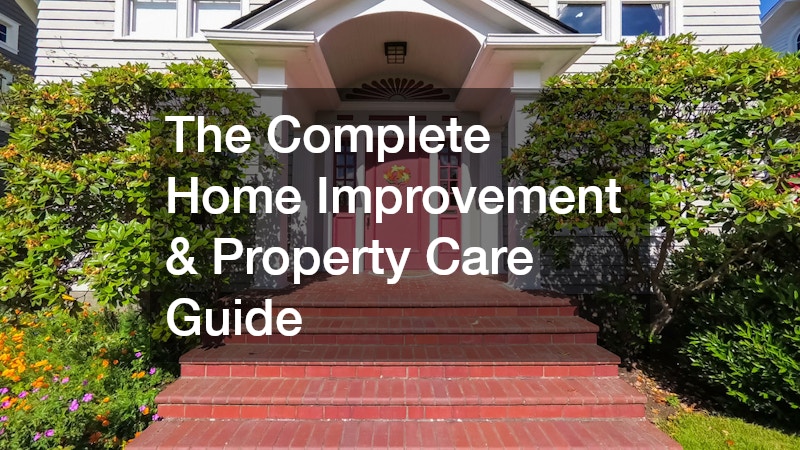A well-maintained home is more than just a comfortable place to live—it’s an investment that grows in value as you take steps to safeguard, upgrade, and modernize it. Every element of a property plays a role in structural integrity, energy efficiency, safety, and long-term performance. From interior systems like ventilation, drainage, and electrical panels to exterior components such as driveways, siding, roofing, and landscaping, the overall condition of your home reflects the care and thoughtfulness put into it. When each part functions properly, the entire property becomes more resilient, efficient, and enjoyable to use.
The challenge many homeowners face is understanding which areas need attention, how to recognize early signs of deterioration, and when it’s time to bring in a professional. Issues often start small—tiny foundation cracks, slow drainage, drafty windows, or minor discoloration on exterior surfaces—but can escalate quickly if overlooked. Knowing what to watch for makes it easier to stay ahead of these problems before they compromise safety or lead to costly repairs. Homeowners also benefit from learning how different systems interact; for example, poor drainage can affect landscaping, which in turn can impact the foundation or exterior siding. By developing a clear maintenance strategy, prioritizing essential upgrades, and using expert help when specialized skills are required, homeowners can confidently protect their property and support its long-term value.
Strengthening Your Driveway and Walkways for Long-Term Performance
How to Evaluate When Your Driveway Needs Professional Attention
Driveways deal with continuous pressure from vehicle weight, temperature changes, and water runoff. Even durable surfaces deteriorate over time, and the earlier issues are caught, the more affordable repairs tend to be.
Signs Your Driveway Needs Attention
-
Alligator cracking that forms interconnected patterns
-
Potholes or depressions, especially near garage entrances
-
Pooling water, which indicates grading issues
-
Loose gravel, crumbling edges, or material separation
-
Faded blacktop, showing oxidation or binder breakdown
The combination of these problems often points toward significant structural decline. Surface-level patching may help temporarily, but substantial or widespread cracking often requires more involved work. Professionals experienced in asphalt paving can assess whether resurfacing or a full replacement is necessary.
Factors to Consider Before Repair or Replacement
-
Driveway age: Asphalt typically lasts 15–20 years before major work is needed.
-
Usage level: Heavy trucks or multiple daily vehicles accelerate wear.
-
Local climate: Freeze-thaw cycles increase cracking risk.
-
Drainage performance: Standing water significantly shortens lifespan.
Driveway care is not only aesthetic—poor surface conditions impact safety, tire wear, and vehicle alignment. Addressing issues early is one of the most cost-effective steps homeowners can take.
Extending Surface Life Through Smart Reinforcement Techniques

Reinforcement methods help pavements resist cracking, moisture infiltration, and stress damage. Among the most effective of these methods is the use of paving fabric installations, especially during resurfacing projects.
Benefits of Surface Reinforcement
-
Prevents reflective cracks from transferring upward
-
Improves waterproofing, protecting underlying base layers
-
Distributes stress loads, reducing future cracking
-
Extends the lifespan of asphalt overlays
-
Improves long-term performance in high-traffic areas
These fabrics work as interlayers that bond the old and new pavement, strengthening the overall structure. They’re particularly beneficial in regions with harsh winters or in older surfaces with existing cracks.
Proper Preparation Before Reinforcement
To ensure the reinforcement layer works properly:
-
Remove vegetation and debris from cracks.
-
Repair major structural failures first.
-
Ensure the base is graded to slope water away from structures.
-
Fill larger cracks with proper hot or cold-applied materials.
-
Allow previous repairs adequate time to cure.
Long-Term Care After Installation
-
Seal cracks promptly to prevent water infiltration.
-
Avoid heavy machinery use during early curing stages.
-
Reapply sealcoating every few years for added protection.
Using reinforcement is a strategic investment that significantly lowers long-term maintenance needs and reduces the frequency of major surface repairs.
Improving Key Indoor Systems for Safety and Comfort
3. What to Prioritize When Updating High-Traffic Interior Spaces
Bathrooms endure constant humidity, temperature swings, and daily wear. Over time, these factors create conditions that can lead to mold, plumbing failures, and structural deterioration. Thoughtful upgrades enhance comfort, improve hygiene, and boost property value.
Key Elements to Prioritize During Upgrades
1. Moisture Control
Moisture is a bathroom’s biggest threat. Effective solutions include:
-
High-capacity exhaust fans
-
Anti-mildew paint
-
Humidity-sensing ventilation
-
Waterproof underlayments behind tile
2. Surface Durability
Choose long-lasting materials such as:
-
Porcelain tiles for flooring and walls
-
Quartz or solid-surface countertops
-
Water-resistant cabinetry
-
Durable grout sealants
3. Improved Accessibility and Safety
Small design choices significantly improve long-term usability:
-
Walk-in showers
-
Grab bars
-
Curbless shower entries
-
Slip-resistant flooring
4. Efficient Layout Design
Professional bathroom remodeling services help design layouts that maximize storage, improve lighting, and streamline plumbing configuration.
Smart Upgrades That Boost Resale Value
-
Dual sinks
-
Frameless glass shower doors
-
LED lighting
-
Energy-efficient fixtures
Bathrooms are among the top areas buyers evaluate, making these upgrades valuable investments.
How to Spot Early Signs of Plumbing Issues Before They Become Expensive

Plumbing problems rarely start big—they grow over time as pipes age, seals weaken, and minerals accumulate. Homeowners who learn to spot early warning signs can prevent extensive water damage and reduce repair costs.
Warning Signs of Plumbing Problems
-
Slow drains often indicate developing clogs deeper in the system.
-
Rattling pipes may signal loose mounting brackets or air pressure issues.
-
Low water pressure can mean pipe corrosion or hidden leaks.
-
Recurring toilet backups suggest venting problems.
-
Unusual odors may indicate sewer line issues.
Preventive Plumbing Habits
-
Avoid flushing wipes, even those labeled “flushable.”
-
Use hair catchers in shower drains.
-
Inspect water heater pressure valves annually.
-
Check supply lines on dishwashers and washing machines.
-
Schedule periodic inspections with professionals specializing in local plumbing systems, as they understand region-specific issues such as mineral content or water pressure norms.
When to Call a Professional Immediately
-
Signs of foundation moisture
-
Sudden pressure drops
-
Colored or rusty water
-
Mold is developing near the pipes
Timely intervention prevents structural damage, mold growth, and escalating repair costs.
Protecting and Enhancing Your Home’s Exterior Structure
How to Choose the Right Exterior Materials for Long-Term Durability
Exterior siding shields your home from wind, moisture, wildlife, and UV exposure. The right material reduces maintenance costs, improves energy efficiency, and contributes significantly to curb appeal.
Factors to Consider When Selecting Exterior Materials
1. Climate Suitability
-
Humid climates benefit from rot-resistant materials.
-
Cold climates require materials that tolerate expansion and contraction.
2. Insulation Value
Some siding options come with built-in insulation, helping lower energy bills.
3. Maintenance Demands
-
Vinyl requires minimal upkeep.
-
Wood provides a classic look but needs regular staining.
-
Fiber cement offers durability with moderate maintenance.
Signs It’s Time for an Exterior Update
-
Warped or bulging panels
-
Cracked or loose boards
-
Fading color
-
Higher energy bills
-
Evidence of insect damage or rot
Experts who offer siding services help assess existing materials and recommend the best long-term solutions for both aesthetics and performance.
Ensuring Proper Window Upkeep to Reduce Energy Loss

Windows play a major role in thermal performance and overall comfort. Inefficient or deteriorating windows contribute to heat loss, condensation issues, and noise infiltration.
Common Issues That Require Window Attention
-
Drafts entering near frames
-
Condensation between panes
-
Cracked glazing or deteriorating seals
-
Difficulty opening or locking windows
-
Visible rot or water staining
Regular Window Maintenance Tips
-
Clean tracks twice a year
-
Reapply caulking around exterior frames
-
Replace damaged screens
-
Inspect wooden frames for softness or discoloration
-
Lubricate hinges and locks to prevent wear
When Replacement Becomes Necessary
If recurring issues persist, contacting a home window replacement service ensures proper installation and material selection. Modern window technologies—such as low-E coatings, argon gas filling, and improved frame designs—offer significant improvements in efficiency and noise reduction.
Optimizing Outdoor Spaces for Beauty and Function
How to Select the Right Materials for All Outdoor Projects
Every outdoor project, from garden beds to patios, relies on choosing the right materials. The longevity and health of your landscape depend heavily on soil composition, mulch type, and the quality of materials used.
Understanding Material Types
Stone and Gravel
Used for drainage, pathways, and decorative accents.
-
Pea gravel works well for walkways.
-
Larger stones help with erosion control.
Mulch
Important for plant protection and soil health.
-
Organic mulches break down and improve soil.
-
Inorganic mulches offer long-term weed suppression.
Soil Mixes
-
Clay-heavy soils require sand or compost.
-
Sandy soils benefit from nutrient-rich amendments.
Tips for Making the Right Choices
-
Match materials to project size and function.
-
Consider color and texture for cohesive design.
-
Account for replenishment needs in your yearly budget.
Partnering with a reliable landscaping supply provider ensures access to the correct materials and expert guidance.
Lighting Tips That Boost Safety, Curb Appeal, and Nighttime Usability

Outdoor lighting transforms your yard into an inviting and functional space while increasing safety and visibility. Thoughtful placement enhances architectural features and extends usability late into the evening.
Best Practices for Outdoor Lighting
1. Use Layered Lighting
Combine ambient, task, and accent lights for balance.
2. Highlight Key Features
-
Trees
-
Garden beds
-
Walkways
-
Architectural details
3. Focus on Safety
Place lights near steps, paths, and uneven surfaces.
Common Mistakes to Avoid
-
Using lights that are too bright
-
Installing fixtures in areas with obstructed light paths
-
Overlapping beams that create glare
-
Poor wiring or insufficient wattage planning
Working with a landscape lighting contractor ensures correct installation, safe wiring, proper transformer selection, and cohesive design. This reduces future maintenance needs and enhances the overall look of your property.
VI. Maintaining a Healthy Landscape Year-Round
9. How to Plan a Landscape That Grows Well in Your Climate
Designing a landscape that thrives requires an understanding of regional climate patterns, soil composition, and plant needs. Selecting the right vegetation reduces watering demands and prevents long-term maintenance issues.
Steps to Planning a Sustainable Landscape
1. Evaluate Your Microclimates
Different areas of your property receive varying amounts of sunlight and wind exposure.
2. Choose Native or Climate-Adapted Plants
These plants naturally resist pests, drought, and temperature extremes.
3. Ensure Proper Drainage
Standing water harms root systems and invites pests.
4. Plan for Mature Plant Size
Crowding leads to disease, poor airflow, and constant trimming.
Professional Guidance
A local landscaping contractor understands your region’s soil profiles, water regulations, pest threats, and seasonal requirements. Their expertise helps prevent expensive installation mistakes and ensures the long-term success of your landscape.
Creating a Lawn Care Routine That Actually Works
A vibrant lawn requires consistent maintenance tailored to your grass type and environment. Many homeowners struggle because they follow general advice rather than a strategic, season-specific plan.
Core Components of Effective Lawn Care
1. Mowing
-
Maintain proper height based on grass species.
-
Vary mowing direction to prevent grain patterns.
-
Avoid scalping the turf, which stresses roots.
2. Watering
-
Water deeply to encourage deep root growth.
-
Avoid evening watering to reduce fungal issues.
-
Adjust schedules based on rainfall patterns.
3. Soil Management
-
Test soil every 1–2 years.
-
Apply lime or sulfur as needed to balance pH.
-
Aerate annually to improve oxygen flow.
4. Fertilization
-
Apply slow-release fertilizers at key growth periods.
-
Overseed bare areas to maintain density.
5. Weed and Pest Control
-
Identify weeds early by leaf shape and growth behavior.
-
Use targeted treatments to avoid harming beneficial plants.
A professional lawn care company can create a tailored routine that addresses your lawn’s specific needs, helping it stay lush and disease-resistant throughout the year.
Maintaining a home requires consistent effort and informed decision-making, but the long-term benefits—improved comfort, enhanced curb appeal, lower repair costs, and increased property value—are well worth the investment of time and attention. When homeowners stay proactive, they not only prevent small problems from turning into expensive emergencies but also create a living environment that feels cleaner, safer, and more enjoyable every day. This involves recognizing early warning signs in major systems, from subtle plumbing issues to minor exterior wear, and taking action before damage escalates. It also means planning upgrades that contribute to long-term performance, such as energy-efficient windows, durable exterior materials, or modernized interiors designed for both function and aesthetics.
Equally important is knowing when to call in trusted professionals with the right training and tools. Skilled experts can diagnose problems accurately, perform repairs safely, and recommend solutions that align with your home’s specific needs. By combining attentive daily care with strategic professional support, homeowners can maintain strong structural integrity, reduce ongoing expenses, and extend the lifespan of essential indoor and outdoor systems. With a proactive mindset and a balanced focus on every part of the property, it becomes much easier to protect your investment, avoid unnecessary stress, and enjoy a home that remains durable, efficient, and beautiful for many years to come.

